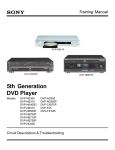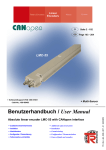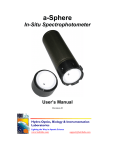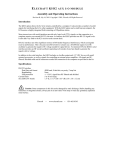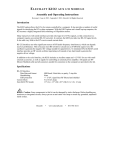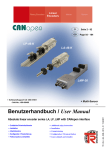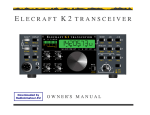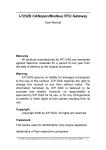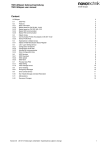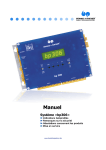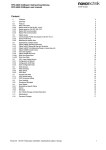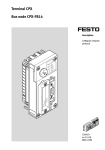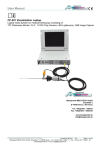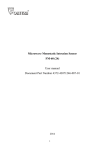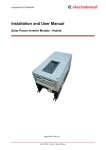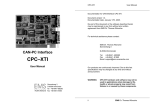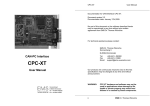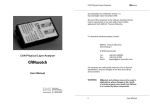Download Product Line CST User Manual
Transcript
Product Line CST User Manual (Preliminary) EMS THOMAS WÜNSCHE Sonnenhang 3 D-85304 Ilmmünster Tel +49-8441-490260 Fax +49-8441-81860 Users Manual Product Line CST User Manual for Product Line CST Document version 2.1 Documentation date: June 12th, 2007 No part of this document or the software described herein may be reproduced in any form without prior written agreement from EMS Dr. Thomas Wünsche! For technical assistance please contact EMS Dr. Thomas Wünsche Sonnenhang 3 D-85304 Ilmmuenster Tel.: +49-8441-490260 Fax: +49-8441-81860 Mail: [email protected] Our products are continuously improved. Due to this fact specifications may be changed at any time and without announcement. WARNING: ii CST devices and accompanying software may not be used in applications where damage to life, health or private property may result from failures in or caused by these components. EMS Dr. Thomas Wünsche Product Line CST Users Manual Contents 1 Overview. . . . . . . . . . . . . . . . . . . . . . . . . . . . . . . . . . . 1 1.1 Features . . . . . . . . . . . . . . . . . . . . . . . . . . . . . . . . 1 1.2 General Description . . . . . . . . . . . . . . . . . . . . . . . . . . 1 1.3 Sample Applications . . . . . . . . . . . . . . . . . . . . . . . . . . 1 1.4 Ordering Information . . . . . . . . . . . . . . . . . . . . . . . . . . 2 2 Communication . . . . . . . . . . . . . . . . . . . . . . . . . . . . . . . 3 2.1 Communication Concept . . . . . . . . . . . . . . . . . . . . . . . . 3 2.2 Operational States . . . . . . . . . . . . . . . . . . . . . . . . . . . 3 2.3 Configuration Mode. . . . . . . . . . . . . . . . . . . . . . . . . . . 4 2.4 Operation Mode . . . . . . . . . . . . . . . . . . . . . . . . . . . . 5 2.5 Mode Switching. . . . . . . . . . . . . . . . . . . . . . . . . . . . . 6 2.6 Identification Services . . . . . . . . . . . . . . . . . . . . . . . . . 8 2.7 Structure of the Variable Index . . . . . . . . . . . . . . . . . . . . 10 2.8 Configuration Example . . . . . . . . . . . . . . . . . . . . . . . . 11 3 General Features . . . . . . . . . . . . . . . . . . . . . . . . . . . . . 15 3.1 Connection Scheme. . . . . . . . . . . . . . . . . . . . . . . . . . 15 3.2 Absolute Limiting Values . . . . . . . . . . . . . . . . . . . . . . . 15 3.3 Nominal Values . . . . . . . . . . . . . . . . . . . . . . . . . . . . 15 3.4 Measurements . . . . . . . . . . . . . . . . . . . . . . . . . . . . 16 4 Module Descriptions . . . . . . . . . . . . . . . . . . . . . . . . . . . 17 CST Digital Module with 8 Inputs 24V . . . . . . . . . . . . . . . . . . 17 CST Digital Module with 8 Outputs 24V/500mA . . . . . . . . . . . . . 19 CST Digital Module with 8 Inputs TTL Level . . . . . . . . . . . . . . . 23 CST Digital Module with 8 Outputs TTL Level . . . . . . . . . . . . . . 25 CST Analogue Module with 8 Inputs 0-10V . . . . . . . . . . . . . . . 27 CST Analogue Module with 4 Inputs 0-25mA/12 Bit . . . . . . . . . . 29 CST Analogue Module with 4 Inputs 0-10V/12 Bit . . . . . . . . . . . . 31 CST Analogue Module with 2 Outputs 0-25mA/12 Bit. . . . . . . . . . 33 CST Analogue Module with 2 Outputs 0-10V/12 Bit . . . . . . . . . . . 35 CST Motor Control Module MC-1100 . . . . . . . . . . . . . . . . . . . 37 CST Incremental Encoder Module with 2 Input Channels . . . . . . . 43 CST Incremental Input Module with Error Detection . . . . . . . . . . 47 EMS Dr. Thomas Wünsche iii Users Manual Product Line CST THIS PAGE INTENTIONALLY LEFT BLANK iv EMS Dr. Thomas Wünsche Product Line CST 1 Overview Overview 1.1 Features • • • • • • • • Multifaceted solution for I/O functions on the CAN bus CiA and ISO 11898 compatible bus interface Automatic data rate detection based on a table with standard values Independent intelligence due to microcontroller 80C32 or DS 80C320 Robust layout (electronics completely enclosed in epoxy resin) Compact structure for use in cramped conditions Modules available for different application types Modular setup for easy adaptation to application demands 1.2 General Description The CAN modules of the CST Product Line are built for distributed input/output in measuring, control and automation uses. Their compact and rugged structure with completely enclosed electronics allows the use not only in a control box but also in proximity of the process. The way of building in connection with high granularity offers the possibility to implement decentralized control solutions consistently. Through the integrated microcontroller CST modules can perform pre-processing functions independently. In many cases, they help to lower the costs for control hardware and installation while offering an enlargement of flexibility at the same time. CST modules are available with a wide range of different functions. In addition to digital input/output with different turn-off levels, analog inputs/outputs, incremental encoders and a digital motor controller are available. A configurable logic module with network computer functionality allows the use of decentralized intelligence and the implementation of critical functions directly into the hardware. CST devices are layouted in a modular manner. The basic element is the base module with processor 80C32, CAN controller Philips SJA1000 and 8k of ROM. The interfaces have been realized with an application module piggybacked on one side of the base module. Different application modules are available. Control functions can be implemented efficiently by use of a programmable variation of the base module. 1.3 Sample Applications The application area of the CST product line is very wide. Some sample application are detailed in the following: • • • • • Remote I/O in control systems Modular large display systems Remote data processing Distributed measurement data acquisition Automation of buildings EMS Dr. Thomas Wünsche 1 Overview Product Line CST 1.4 Ordering Information 2 Article Number Description 11-00-001-20 CST-DI8-TTL 8 digital input channels, TTL level 11-00-002-20 CST-DO8-TTL 8 digital output channels, TTL level 11-00-103-20 CST-DI8-24V 8 digital input channels 24V 11-00-104-20 CST-DO8H-24V/500mA 8 digital output channels, 24V/500mA 11-00-005-20 CST-AI8-8-0/10V 8 analog input channels 0-10V, 8 bit resolution 11-00-006-20 CST-AI8-8-0/10V-RO 8 analog input channels 0-10V, 8 bit resolution, reference output for potentiometer supply 11-00-007-20 CST-AI4-12-0/10V 4 analog input channels 0-10V, 12 bit resolution, galvanically separated 11-00-008-20 CST-AI4-12-0/25mA 4 analog input channels 0-25mA, 12 bit resolution, galvanically separated 11-00-009-20 CST-A02-12-0/10V 2 analog ouput channels 0-10V, 12 bit resolution, galvanically separated 11-00-010-20 CST-A02-12-0/25mA 2 analog output channels, 0-25mA, 12 bit resolution, galvanically separated 11-00-111-20 CST-II2-TTL 2 channel incremental encoder, 24 bit resolution, galvanically separated 11-00-112-20 CST-II1ED-TTL 1 channel incremental encoder, 24 bit resolution, error detection, galvanically separated 11-00-113-20 CST-MC1100 Digital motor controller for synchronous, asynchronous and stepping motors, galvanically separated 11-00-901-20 CST-MKR Clamp for CST modules, assembly rail fixing 11-00-902-20 CST-MKS Clamp for CST modules, screw fixing EMS Dr. Thomas Wünsche Product Line CST 2 Communication Communication 2.1 Communication Concept The control of the CST devices takes place through module specific variables that can be accessed by messages (COB: Communication Object) with configurable CAN identifiers (COB id’s). These variables have reading and writing access. Furthermore events can be triggered when state changes occur (e.g. modification of input signals). The devices are (complying to the CAL LMT protocol following CiA) completely configurable over the CAN bus. The assignment of COB id’s takes place dynamically during the initialization of the network, the data rate is recognized by the device by means of a table containing standard data rates. 2.2 Operational States For distinction between configuration and normal operation CST devices operate in two states, a configuration mode and an operation mode. The transitions between the operating modes are influenced through mode switching commands. Configuration Mode Switch Mode Global with parameter Operation_Mode Switch Mode Global with parameter Configuration_Mode Switch Mode Selective with suitable LMT-Address-parameter Operation Mode Figure 1: CST module operating states and transitions. The common procedure after power on of the system follows the following steps: • • • • • Switching the CST device into configuration mode Assignment of COB Id’s for the variables to use Optional: offset assignment to write variables Switching the CST device into operation mode by using Switch Mode Global Operation of the system through the configured identifierConfiguration Mode EMS Dr. Thomas Wünsche 3 Communication Product Line CST 2.3 Configuration Mode In configuration mode COB identifiers for reading and writing operations as well as for event notification are determined for individual variables through a compatible extension of the CAL LMT protocol. The variables represent the state of the inputs and outputs and are described in the CST data sheets. Figure 2 shows the protocol for the assignment of COB id’s. Assign COB-Id for Variable ConfigMaster cs: ty: vn: id: 0 1 2 3 cs=128 ty vn COB-Id = 2021 lsb 4 id 5 ConfigSlave msb command specifier variable access type (0 write, 1 read, 2 event) variable number COB-Id (least significant byte first) Figure 2: Assigning a COB id to a module variable By the declaration of an offset it is possible to determine for certain write variables, which part of the data field should be evaluated. Through this mechanism it is possible to set several outputs on different CST devices by transmitting only one COB. The default offset is set to 0. Figure 3 shows the protocol used for the assignment of an offset. Assign Start-Bit for Write Variable Operation 0 ConfigMaster 1 cs=129 vn 2 3 ConfigSlave sbit COB-Id = 2021 cs: vn: sbit: command specifier variable number start-bit of value within COB Figure 3: Assigning an offset to a module variable 4 EMS Dr. Thomas Wünsche Product Line CST Communication 2.4 Operation Mode In operation mode the data exchange between one or more control units and CST devices takes place through the configurated COB id’s. Figure 4 shows the protocol sequences used in operation mode. Write Variable 0 Client offset val Configured COB-Id Server Read Variable Client RTR Frame Configured COB-Id Server 0 val Configured COB-Id 0 Client Event Server val Configured COB-Id Configured COB-Id: val: offset: COB-Id configured for this variable and access mode value of the variable offset of value from start of message Figure 4: Protocol sequences for variable access in operation mode With values longer than a byte the least significant byte is transmitted first, the most significant byte is transmitted last. The transmit position of a value with an offset (writing variables) is obtained by casting the value into a longer variable corresponding to the offset and then shifting it left depending on the dimension of the offset. EMS Dr. Thomas Wünsche 5 Communication Product Line CST 2.5 Mode Switching To change the operational modes commands for mode switching are provided. Switch Mode Selective switches the CST device specified by the adress parameters into configuration mode. Figure 5 shows the protocol used to perform switch Mode Selective. Switch Mode Selective 0 ConfigMaster 1 8 ConfigSlave manufacturer_name cs = 01 COB-Id = 2021 0 1 cs = 02 8 product_name COB-Id = 2021 00 1 1 cs = 03 8 serial_number COB-Id = 2021 command specifier cs: manufacturer_name: ASCII characters "EMS_T_W" product_name: characterisation of product (7 ASCII chars), see individal product data sheets BCD-coded serial number (14 digits) with serial_number: first pair of digits in first byte of serial_number, first digit of a pair in the high order bits of a byte Figure 5: Protocol sequence used for Switch Mode Selective The successive messages for Switch Mode Selective should be sent with a space of at least 5ms. 6 EMS Dr. Thomas Wünsche Product Line CST Communication Switch Mode Global switches between operation mode and configuration mode for all CAL-LMT compatible modules (clases 1, 2) attached to the network. Figure 6 shows the protocol used to perform Switch Mode Global. Switch Mode Global 0 ConfigMaster 1 2 cs = 04 mode 8 reserved ConfigSlave COB-Id = 2021 cs: command specifier mode: mode to set: 0 switches to operation mode 1 switches to configuration mode Figure 6: Protocol used for Switch Mode Global EMS Dr. Thomas Wünsche 7 Communication Product Line CST 2.6 Identification Services The LMT address parameters of a device currently switched to configuration mode can be inquired. Figure 7 shows the protocol sequences used to get those parameters. Inquire Manufacturer Name 0 ConfigMaster 1 8 cs = 36 ConfigSlave reserved COB-Id = 2021 0 1 8 manufacturer_name cs = 36 COB-Id = 2020 Inquire Product Name 0 ConfigMaster 1 8 ConfigSlave reserved cs = 37 COB-Id = 2021 0 1 8 product_name cs = 37 COB-Id = 2020 Inquire Serial Number 0 ConfigMaster 1 8 cs = 38 ConfigSlave reserved COB-Id = 2021 0 1 8 serial_number cs = 38 COB-Id = 2020 cs: manufacturer_name: product_name: serial_number: command specifier ASCII characters "EMS_T_W" characterisation of product (7 ASCII chars) BCD-coded serial_number (14 digits) Figure 7: Protocol sequence to inquire the LMT parameters This function can be used to identify an unknown CST device. Therefore, the device has to be operated exclusively in the CAN network and has to be switched into configuration mode by using the function Switch Mode Global. Afterwards an inquiery of the LMT parameters can be done. 8 EMS Dr. Thomas Wünsche Product Line CST Communication To check the module version a function is implemented in the firmware beginning with version x.3.x that provides inquirery of the version of the hardware, the communication firmware and the module software. Figure 8 shows the protocol used to inquire the version number. Inquire Version Number 0 ConfigMaster 1 8 cs=131 reserved ConfigSlave COB-Id = 2021 0 1 hw fw sw COB-Id = 2020 hw: hardware-version fw: communication firmware version sw: module software-version Figure 8: Protocol used for the version inquiery EMS Dr. Thomas Wünsche 9 Communication Product Line CST 2.7 Structure of the Variable Index Control-/Status register CST devices have a Control-/Status section, that can be accessed through variable number 0. The control section is affected by writing operations and consists of several 16 bit registers manipulated by a 5 byte message. The selection of the register to manipulate is done by the first byte of the message, the following 2 bytes contain the value to store, and the last two bytes contain a mask releasing the bits to manipulate. Only active bits (bits set to 1) in the mask can be affected in the control register. The control register 0 contains flags influencing the behaviour of the CST device on the CAN bus. The following bits are defined (current version x.3.x): Bit-Nr. Function (Bit set to 1) 0 Auto Bus On The device reactivates its CAN controller, if it switched into bus off state because of errors. 1 Auto Baud The device detects the data rate, if it has been changed during operation. The status register Reading the status register returns a message of 4 bytes. The first two bytes contain the bus state, the following two bytes contain the module state. Changes occuring in the status register may trigger events with certain devices. The bus state currently returns a copy of the control register 0. 10 EMS Dr. Thomas Wünsche Product Line CST Communication 2.8 Configuration Example The following configuration example shows the configuration for a CST module of type CST–DO8–24V/500mA. General structure of a CAN message (here with 8 bytes of data): ID Length Data 0x7E5 0x08 0x01 0x02 0x03 0x0x 0x05 0x06 0x07 0x08 0x7E5 (= 2021 decimal) is a specific identifier used for the configuration, 0x7E4 (= 2020 decimal) is used by the module when answering to a request. All values are hexadecimal values. Important values within the CAN messages are printed in bold face. Synchronisation CST modules perform an automatic baudrate detection for baudrates following the CiA standard. To synchronize modules connected to the bus to the required baudrate, one should send synchronisation messages, preferably with varying time intervalls (0–10ms): 0x7E5 0x7E5 0x7E5 0x7E5 0x7E5 0x08 0x08 0x08 0x08 0x08 0x01 0x01 0x01 0x01 0x01 0x02 0x02 0x02 0x02 0x02 0x03 0x03 0x03 0x03 0x03 0x04 0x04 0x04 0x04 0x04 0x05 0x05 0x05 0x05 0x05 0x06 0x06 0x06 0x06 0x06 0x07 0x07 0x07 0x07 0x07 0x08 0x08 0x08 0x08 0x08 Depending on the number of modules connected to the bus one should send up to 500 synchronisation messages. Mode Switching into the Configuration Mode There now are two possibilities to configure the modules: 1. Switch Mode Global (Condition: Only one module connected to the bus!) 0x7E5 0x02 0x04 0x01 0x7E5 0x01 0x82 Switch the module into configuration mode Check presence of the module If the configuration parameters are unknown, they can be inquired through the following 3 messages (time intervall about 5ms): 0x7E5 0x01 0x24 0x7E5 0x01 0x25 0x7E5 0x01 0x26 Manufacturer (”EMS_T_W”) Product name.(”CSTxxxx”) Serial number (binary coded decimal value with 7 digits) The module should then answer with the following messages (example): 0x7E4 0x08 0x24 0x45 0x4D 0x53 0x5F 0x54 0x5F 0x57 (”EMS_T_W”) 0x7E4 0x08 0x25 0x43 0x53 0x54 0x30 0x30 0x30 0x31 (”CST0001”) 0x7E4 0x08 0x26 0x00 0x00 0x00 0x00 0x00 0x01 0x78 (00000178) The different variables can now be configured (see below) EMS Dr. Thomas Wünsche 11 Communication Product Line CST After the configuration the module has to be switched back into operating mode: 0x7E5 0x02 0x04 0x00 Switch to operating mode 2. Switch Mode Selective (specific selection of a module connected to the bus) Switch the module into configuration mode (time intervall about 5ms): 0x7E5 0x08 0x01 0x45 0x4D 0x53 0x5F 0x54 0x5F 0x57 (”EMS_T_W”) 0x7E5 0x08 0x02 0x43 0x53 0x54 0x30 0x30 0x30 0x31 (”CST0001”) 0x7E5 0x08 0x03 0x00 0x00 0x00 0x00 0x00 0x01 0x78 (00000178) Check presence of the device, e.g. Inquire serial number 0x7E5 0x01 0x26 serial number The module should then answer with the following message (example): 0x7E4 0x08 0x03 0x00 0x00 0x00 0x00 0x00 0x01 0x78 (00000178) The different variables can now be configured. After the configuration the module has to be switched back into operating mode: 0x7E5 0x02 0x04 0x00 switch to operating mode Configuration of the Variables To configure the module, it has to be switched into configuration mode using one of the methods decribed above. Now, the variables can be configured. There are 3 different ways to access the variables: 1. Write access (0): 2. Read access (1): 3. Event access (2): write a value to a variable (e.g. Set an output) read a value from a variable (e.g read an input) generates a message in case of an occuring event Not every variable can be accessed by all of the access types described above. The COB-Id (will be used later as the identifier of a specific messages) has to be splitted in high and low bytes before transmission. Define COB-Id 0x14 for reading access to the byte variable (Var1: all channels): 0x7E5 0x05 0x80 0x01 0x01 0x14 0x00 Define COB-Id 0x214 for reading access to the byte variable (Var1): 0x7E5 0x05 0x80 0x01 0x01 0x14 0x02 Configuration of the control variable (Var0) for writing access (0) with COB 0x10 0x7E5 0x05 0x80 0x00 0x00 0x10 0x00 Configuration of the status variable (Var0) for reading access (1) with COB 0x11 0x7E5 0x05 0x80 0x01 0x00 0x11 0x00 Configuration of the status variable (Var0) for event access (2) with COB 0x12 0x7E5 0x05 0x80 0x02 0x00 0x12 0x00 12 EMS Dr. Thomas Wünsche Product Line CST Communication Configuration of the byte variable (Var1) for writing access (0) with COB 0x33 0x7E5 0x05 0x80 0x00 0x01 0x33 0x00 Configuration of the byte variable (Var1) for reading access (1) with COB 0x34 0x7E5 0x05 0x80 0x01 0x01 0x34 0x00 Now the different channels (outputs) are configured (example: 4 channels): Configuration of the channel0 variable (Var2) for writing access (0) with COB 0x35 0x7E5 0x05 0x80 0x00 0x02 0x35 0x00 Configuration of the channel1 variable (Var3) for writing access (0) with COB 0x36 0x7E5 0x05 0x80 0x00 0x03 0x36 0x00 Configuration of the channel2 variable (Var4) for writing access (0) with COB 0x37 0x7E5 0x05 0x80 0x00 0x04 0x37 0x00 Configuration of the channel6 variable (Var8) for writing access (0) with COB 0x38 0x7E5 0x05 0x80 0x00 0x08 0x38 0x00 The configuration is finished, the module has to be switched back into operating mode: 0x7E5 0x02 0x04 0x00 Switch modul into operating mode Verification of the configuration Inquire the status of the module (important: the RTR bit has to be set) 0x011 0x04 RTR-Frame !! Now set the channels 2 and 6 0x033 0x01 0x22 data frame 0x034 0x04 RTR-Frame (inquire status of the channels) Reset all channels 0x033 0x01 0x00 0x034 0x04 data frame RTR-Frame (inquire status of the channels) Set channel 0 0x035 0x01 0x01 0x034 0x04 data frame RTR-Frame (inquire status of the channels) Set channel 1 0x036 0x01 0x01 0x034 0x04 data frame RTR-Frame (inquire status of the channels) Set channel 2 0x037 0x01 0x01 0x034 0x04 data frame RTR-Frame (inquire status of the channels) Set channel 6 0x038 0x01 0x01 0x034 0x04 data frame RTR-Frame (inquire status of the channels) EMS Dr. Thomas Wünsche 13 Communication Product Line CST Configuration using an offset During the configuration an offset can be specified to ‘shift’ the values within a message. This offers the possibility to access a couple of modules later at the same time using only one CAN message when in operating mode. The specific module will then evaluat the values at different positions within the CAN messages. Example: Set an offset of 8 for the byte variable (Var 1). Thus, the second byte within a message will be valid for this module. 0x7E5 0x03 0x81 0x01 0x08 If the byte variable for this module is addressed later, the module will evaluate the second byte within the received CAN message. A message would have the following structure: Set channels 2 and 6 (see example above) 0x033 0x02 0x00 0x22 data frame 0x034 0x04 RTR-Frame (inquire status of the channels) If the offset is not needed, this step can be omitted during configuration. 14 EMS Dr. Thomas Wünsche Product Line CST 3 General Features General Features 3.1 Connection Scheme The CAN interface connector (D-Sub 9 male) complies to CiA standard DS 102-1. The pin usage is detailed in the following table: Pin 1 – Pin 2 CAN_L Pin 3 Gnd Pin 4 – Reserved by CiA Pin 5 – Reserved by CiA Pin 6 (Gnd) Pin 7 CAN_H Pin 8 – Pin 9 V+CAN Reserved by CiA CAN_Low bus line (dominant low) Ground Optional ground, internally connected to Pin 3 CAN_High bus line (dominant high) Reserved by CiA (error signal) Positive power supply from CAN Bus 3.2 Absolute Limiting Values In the following table, the limiting values of the bus interface are summarized. The application specific limiting values are stated in the different module data sheets. Any (also temporary) stress in excess of the limiting values may cause permanent damage on the devices. Parameter Min. Max. Unit Storage temperature – 20 +80 °C 0 +60 °C Supply voltage ** –100 +16 V Voltage on bus connections – 4,7 +16 V Current across ground connection –1 +1 A Operating temperature * * ** Note: Extended temperature range upon request V+CAN Modules marked VS24 on the name plate are layouted for differing supply voltages. 3.3 Nominal Values The following table shows the nominal values of the CST product line Parameter Current consumption (logic) Supply voltage* Bus data rate * Min. Typ. Max. Unit – 75 110 mA +7 – + 14 V – 10, 20, 50, 100, 125, 250, 500, 800, 1000 – kBit/s V+CAN EMS Dr. Thomas Wünsche 15 General Features Product Line CST 3.4 Measurements The module descriptions can be obtained from the specific module datasheets thread bolt 4 - 40 UNC feeder clip 0,08 - 0,5 qmm . . 22 + - 1 hexagon bolt SW 5 internal thread 4 - 40 UNC 6,5 Sub-D9 connector + + 99 + - 1 ! picture not full scale ! 1 1 12 3 4 5 6 7 8 9 0 1 1 1 12 3 4 5 6 7 8 9 0 1 5,8 31 5 feeder clip 1 feeder clip 2 number of feeder clips and clips varies Updated: July 1999 CST Product Line all measurements without tolerance specification have tolerance + - 0,5 mm edges rounded 16 EMS Dr. Thomas Wünsche Sonnenhang 3 D-85304 Ilmmünster EMS Dr. Thomas Wünsche Data Sheets CST DI8-24V CST Digital Module with 8 Inputs 24V Features • 8 digital input channels 24V • 2 terminal blocks with 10 clamps for wiring • Signals input level changes Assignment of theTerminal Blocks Terminal Block 1 (inner block) Clamp Name 1 Chan_0 Input channel 0 2 Chan_1 Input channel 1 3 Chan_2 Input channel 2 4 Chan_3 Input channel 3 5 Chan_4 Input channel 4 6 Chan_5 Input channel 5 7 Chan_6 Input channel 6 8 Chan_7 Input channel 7 9 10 Gnd Function Reserved, do not connect Common ground for CAN bus and CST node Terminal Block 2 (outer block) Clamp Name 1 -9 10 Gnd Function These clamps are connected internally. They can be connected eitehr to 24V or to ground potential, Common ground for CAN bus and CST node Operation Indication The meaning of the different indicators is shown within the following table. The position of the indicators refers to the clamp mounted at the same height as the indicator. Position Colour 1 green Switching condition channel 0 2 green Switching condition channel 1 3 green Switching condition channel 2 4 green Switching condition channel 3 5 green Switching condition channel 4 6 green Switching condition channel 5 7 green Switching condition channel 6 8 green Switching condition channel 7 10 red Module initialization successful EMS Dr. Thomas Wünsche Function 17 CST DI8-24V Data Sheets CAN Communication The module is accessed by 1 write, 10 read and 9 event variables. The message id’s for the variable access are assigned during the the configuration (see CST product line manual). LMT-Address The module with 12V supply has the LMT product name CST0003. The module with 24V supply has the LMT product name CST1003. Index of the Variables Variable Nr. Length Access Description Control 0 5 byte write Write to control registers Status 0 1 byte read Read the status All_Chan 1 1 byte read/event Read all channels, status change of at least one channel Chan_0 2 1 byte read/event Read/Status change of channel 0 Chan_1 3 1 byte read/event Read/Status change of channel 1 Chan_2 4 1 byte read/event Read/Status change of channel 2 Chan_3 5 1 byte read/event Read/Status change of channel 3 Chan_4 6 1 byte read/event Read/Status change of channel 4 Chan_5 7 1 byte read/event Read/Status change of channel 5 Chan_6 8 1 byte read/event Read/Status change of channel 6 Chan_7 9 1 byte read/event Read/Status change of channel 7 Registers of the Control Section The control section only contains the module specific flags described in the CST product line manual. Registers of the Status Section The status section only contains the module specific flags described in the CST product line manual. Nominal Values Minimum Typical Maximum Unit Threshold voltage of input stage 5 V Hysteresis 0,5 V Parameter Furthermore the nominal values specified within the chapter ‘General Features’ have to be considered. Limiting Values Parameter Input voltage Minimum Maximum Unit 0 30 V Furthermore the limiting values specified within the chapter ‘General Features’ have to be considered. 18 EMS Dr. Thomas Wünsche Data Sheets CST-D08 H-24V/500mA CST Digital Module with 8 Outputs 24V/500mA Features • • • • 8 digital output channels with 24V/500mA switching power 2 terminal blocks with 11 clamps for wiring Monitoring of the supply voltage within the power circuit Short circuit and overload-proof outputs Assignment of the Terminal Blocks Terminal Block 1 (inner block) Clamp Name Function 1 Chan_0 Output channel 0 2 Chan_1 Output channel 1 3 Chan_2 Output channel 2 4 Chan_3 Output channel 3 5 Chan_4 Output channel 4 6 Chan_5 Output channel 5 7 Chan_6 Output channel 6 8 Chan_7 Output channel 7 9 10 Gnd 11 V+ Reserved, do not connect Common Ground for CAN bus and CST node Positive supply power circuit Terminal Block 2 (outer block) Clamp Name 1– 9 10 Gnd 11 V+ EMS Dr. Thomas Wünsche Function These clamps represent the second connection for the load. Connected to ground potential. Common Ground for CAN bus and CST node Positive supply power circuit 19 CST-D08 H-24V/500mA Data Sheets Operation Indication The meaning of the different indicators is shown within the following table. The position of the indicators refers to the clamp mounted at the same height as the indicator. Position Colour 1 green Switching condition channel 0 2 green Switching condition channel 1 3 green Switching condition channel 2 4 green Switching condition channel 3 5 green Switching condition channel 4 6 green Switching condition channel 5 7 green Switching condition channel 6 Switching condition channel 7 Function 8 green 10 red Supply voltage for the logic connected 11 red Supply voltage for the output stages is connected. This indicator is not updated during the baudrate detection procedure. Changes when connecting or disconnecting the power supply indicate a correct baudrate detection. CAN Communication The module is accessed by 10 write, 10 read and 1 event variable. The message id’s for the variable access are assigned during the configuration (see CST product line manual). LMT Address The module with 12V supply has the LMT product name CST0001. The module with 24V supply has the LMT product name CST1001. Index of the variables Nr. Length Control 0 Status Variable 20 Access Description 5 Byte write Write to control registers 0 4 Byte read Read the status All_Chan 1 1 Byte write/read Write/Read all channels Chan_0 2 1 Byte write/read Write/Read channel 0 Chan_1 3 1 Byte write/read Write/Read channel 1 Chan_2 4 1 Byte write/read Write/Read channel 2 Chan_3 5 1 Byte write/read Write/Read channel 3 Chan_4 6 1 Byte write/read Write/Read channel 4 Chan_5 7 1 Byte write/read Write/Read channel 5 Chan_6 8 1 Byte write/read Write/Read channel 6 Chan_7 9 1 Byte write/read Write/Read channel 7 EMS Dr. Thomas Wünsche Data Sheets CST-D08 H-24V/500mA Registers of the Control Section The control section of the modules consists of 4 registers: • Register 0 contains bus specific flags and is described in the CST product line • • • manual; Register 1 is not used; Register 2 contains module specific flags shown in the following table; Register 3 represents a mask, the bits of witch enable the event triggering in case of a change of the module specific status (default: all events disabled). Bit Function 0 reserved 1 Enable output, if supply voltage for the power circuit in 12V mode is connected 2 Enable output, if supply voltage for the power circuit in 24V mode is connected (default) Registers of the Status Section The structure of the status registers is described in the CST product line configuration manual. The occupancy of the module specific part is shown in the following table. Bit Event Function 0 reserved 1 yes Supply voltage for the power circuit in 12V mode is connected 2 yes Supply voltage for the power circuit in 24V mode is connected 3 reserved 4 yes Output stage is enabled Nominal Values Min. Typ. Max. Unit Supply voltage V+ 8 12/24 28 V Output current (per channel) 0 500 mA Reduction of total current at environmental temperature > 40°C 100 mA/°C Threshold value to enable Ouput in 12V mode 10 V Threshold value to enable Ouput in 24V mode 20 V Parameter Furthermore the nominal values specified within the chapter ‘General Features’ have to be considered. Limiting Values Parameter Supply voltage V+ Min. Max. Unit 0 30 V Furthermore the limiting values specified within the chapter ‘General Features’ have to be considered. EMS Dr. Thomas Wünsche 21 CST-D08 H-24V/500mA Data Sheets THIS PAGE INTENTIONALLY LEFT BLANK 22 EMS Dr. Thomas Wünsche Product Line CST CST-DI8-TTL CST Digital Module with 8 Inputs TTL Level Features • 8 digital input channels with TTL level • 2 terminal blocks with 10 clamps for wiring • Signals input level changes Assignment of the Terminal Blocks Terminal Block 1 (inner block) Clamp Name 1 Chan_0 Input channel 0 2 Chan_1 Input channel 1 3 Chan_2 Input channel 2 4 Chan_3 Input channel 3 5 Chan_4 Input channel 4 6 Chan_5 Input channel 5 7 Chan_6 Input channel 6 8 Chan_7 Input channel 7 9 10 Gnd 11 ExtPWR Function Reserved, do not connect Common ground for CAN bus and CST node Power supply +5V for external logic Terminal Block 2 (outer block) Clamp Name 1 -- 10 Gnd 11 ExtPWR Function Common ground for CAN bus and CST node Power supply +5V for external logic Operation Indication The meaning of the different indicators is shown within the following table. The position of the indicators refers to the clamp mounted at the same height as the indicator. Position Colour 1 green Switching condition channel 0 2 green Switching condition channel 1 3 green Switching condition channel 2 4 green Switching condition channel 3 5 green Switching condition channel 4 6 green Switching condition channel 5 7 green Switching condition channel 6 8 green Switching condition channel 7 10 red Internal supply voltage connected 11 red Supply voltage for external logic connected EMS Dr. Thomas Wünsche Function 23 CST-DI8-TTL Product Line CST CAN Communication The module is accessed by 1 write, 10 read and 9 event variables. The message id’s for the variable access are assigned during the configuration (see CST product line configuration manual). LMT-Address The module has the LMT product name CST0009. Index of the Variables Variable Nr. Length Access Description Control 0 5 Byte Write Write to control registers Status 0 1 Byte Read Read the status All_Chan 1 1 Byte Read/Event Read all channels, status change of at least one channel Chan_0 2 1 Byte Read/Event Read/Status change channel 0 Chan_1 3 1 Byte Read/Event Read/Status change channel 1 Chan_2 4 1 Byte Read/Event Read/Status change channel 2 Chan_3 5 1 Byte Read/Event Read/Status change channel 3 Chan_4 6 1 Byte Read/Event Read/Status change channel 4 Chan_5 7 1 Byte Read/Event Read/Status change channel 5 Chan_6 8 1 Byte Read/Event Read/Status change channel 6 Chan_7 9 1 Byte Read/Event Read/Status change channel 7 Registers of the Control Section The control section only contains the module specific flags described in the CST product line manual. Registers of the Status Section The status section only contains the module specific flags described in the CST product line manual. Nominal Values Parameter Threshold voltage of input stage Minimum Typical Maximum Unit 0,8 2,4 V Furthermore the nominal values specified within the chapter ‘General Features’ have to be considered. Limiting Values Parameter Input voltage Min. Max. Unit 0 5 V Furthermore the limiting values specified within the chapter ‘General Features’ have to be considered. 24 EMS Dr. Thomas Wünsche Data Sheets CST-D08-TTL CST Digital Module with 8 Outputs TTL Level Features • 8 digital outputs with TTL level • 2 terminal blocks with 11 clamps for wiring Terminal Block 1 (inner block) Clamp Name 1 Chan_0 Output switch channel 0 2 Chan_1 Output switch channel 1 3 Chan_2 Output switch channel 2 4 Chan_3 Output switch channel 3 5 Chan_4 Output switch channel 4 6 Chan_5 Output switch channel 5 7 Chan_6 Output switch channel 6 8 Chan_7 Output switch channel 7 9 10 Gnd Common ground for CAN bus and process 11 ExtPWR Power supply +5V for external logic (output) Function Reserved, do not use Terminal Block 2 (outer block) Clamp Name 1 – 10 Gnd Common ground for CAN bus and process 11 ExtPWR Power supply +5V for external logic (output) Function Operation Indication The meaning of the different indicators is shown within the following table. The position of the indicators refers to the clamp mounted at the same height as the indicator. Position Colour 1 green Switching condition channel 0 2 green Switching condition channel 1 3 green Switching condition channel 2 4 green Switching condition channel 3 5 green Switching condition channel 4 6 green Switching condition channel 5 7 green Switching condition channel 6 8 green Switching condition channel 7 10 red Internal power supply connected 11 red Power supply for external logic connected EMS Dr. Thomas Wünsche Function 25 CST-D08-TTL Data Sheets CAN Communication The module is accessed by 10 write, 10 read and 1 event variable. The message id’s for the variable access are assigned during the configuration (see CST product line manual). LMT-Address The module has the LMT product name CST0010. Index of the Variables Nr. Length Access Description Control 0 5 Byte Write Write to control register Status 0 4 Byte Read/Event Read/change of status All_Chan 1 1 Byte Write/Read Write/read all channels Chan_0 2 1 Byte Write/Read Write/read channel 0 Chan_1 3 1 Byte Write/Read Write/read channel 1 Chan_2 4 1 Byte Write/Read Write/read channel 2 Chan_3 5 1 Byte Write/Read Write/read channel 3 Chan_4 6 1 Byte Write/Read Write/read channel 4 Chan_5 7 1 Byte Write/Read Write/read channel 5 Chan_6 8 1 Byte Write/Read Write/read channel 6 Chan_7 9 1 Byte Write/Read Write/read channel 7 Variable Registers of the Control Section The control section only contains the module specific flags described in the CST product line manual. Registers of the Status Section The status section only contains the module specific flags described in the CST product line manual. Nominal Values Min. Typ. Max. Unit Output current (low, V = 0,6V) 5 mA Output current (high, V = 2,4V) 5 mA Parameter Furthermore the nominal values specified within the chapter ‘General Features’ have to be considered. Limiting Values Parameter Min. Max. Unit Output current (low) 20 mA Output current (high) 20 mA Sum of all output currents 50 mA Furthermore the limiting values specified within the chapter ‘General Features’ have to be considered. 26 EMS Dr. Thomas Wünsche Data Sheets CST-AI8-8-0/10V CST Analogue Module with 8 Inputs 0-10V Features • • • • 8 analogue inputs 0-10V with 8 bits resolution 2 terminal blocks with 10 clamps for wiring Synchronous scanning of all channels Reference output 10V (only Version CST-AI8-8-0/10V-RO) Assignment of the Terminal Blocks Terminal Block 1 (inner block) Name Clamp Function 1 Chan_0 Input channel 0 2 Chan_1 Input channel 1 3 Chan_2 Input channel 2 4 Chan_3 Input channel 3 5 Chan_4 Input channel 4 6 Chan_5 Input channel 5 7 Chan_6 Input channel 6 8 Chan_7 Input channel 7 9 10 RefOut Reserved, do not connect Reference output 10V (only version CST-AI8-8-0/10V-RO) Terminal Block 2 (outer block) Clamp Name 1 – 10 Gnd Function Common ground for CAN bus and CST node Operation Indication The meaning of the different operation indicators is shown within the following table. The position of the indicators refers to the clamp mounted at the same height as the indicator. Position Colour 9 red Function Module initialized correctly CAN Communication The module is accessed by 1 write and 10 read variables. The message id’s for the variable access are assigned during the configuration (see CST product line configuration manual) LMT Address The module has the LMT product name CST0011. The module with reference output (RO) has the LMT product name CST0007. EMS Dr. Thomas Wünsche 27 CST-AI8-8-0/10V Data Sheets Index of the Variables Nr. Length Access Control 0 5 Byte write Write to control registers Status 0 1 Byte read Read the status All_Chan 1 8 Byte read Read all channels with synchronized scanning Chan_0 2 1 Byte read Read channel 0 Chan_1 3 1 Byte read Read channel 1 Chan_2 4 1 Byte read Read channel 2 Chan_3 5 1 Byte read Read channel 3 Chan_4 6 1 Byte read Read channel 4 Chan_5 7 1 Byte read Read channel 5 Chan_6 8 1 Byte read Read channel 6 Chan_7 9 1 Byte read Read channel 7 Variable Description Registers of the Control Section The control section only contains the module specific flags described in the CST product line configuration manual. Registers of the Status Section The status section only contains the module specific flags described in the CST product line configuration manual. Nominal Values Parameter Min. Typ. Max. Unit Reference output (at 25°C, version RO) 9,970 10 10,030 V Channel deviation compared to the reference –1 1 Bit Temperature drift of the reference – 100 100 ppm/°C Furthermore the nominal values specified within the chapter ‘General Features’ have to be considered. Limiting Values Parameter Input voltage Min. Max. Unit 0 30 V Furthermore the limiting values specified within the chapter ‘General Features’ have to be considered. 28 EMS Dr. Thomas Wünsche Data Sheets CST-AI4-12-0/25mA CST Analogue Module with 4 Inputs 0-25mA/12 Bit Features • • • • 4 analogue inputs with 0-25mA input range and 12 bit resolution Accuracy 0,2% Sample Time <1ms per channel Galvanic separation between bus and process ground Assignment of the Terminal Blocks Terminal Block 1 (inner block) Clamp Name Function 1 Chan_0 Input channel 0 2 AGnd Process ground 3 Chan_1 Input channel 1 4 AGnd Process ground 5 Chan_2 Input channel 2 6 AGnd Process ground 7 Chan_3 Input channel 3 8 AGnd Process ground 9 AGnd Process ground 10 V+ Positive voltage supply (input, 24V) Terminal Block 2 (outer block) Clamp Name Function 1 V+ Positive voltage supply (input, 24V) 2 AGnd Process ground 3 V+ Positive voltage supply (input, 24V) 4 AGnd Process ground 5 V+ Positive voltage supply (input, 24V) 6 AGnd Process ground 7 V+ Positive voltage supply (input, 24V) 8 AGnd Process ground 9 AGnd Process ground 10 V+ Positive voltage supply (input, 24V) All clamps AGnd are internally connected. All clamps V+ are internally connected. All voltages on the terminal blocks relate toAGnd. Operation Indication Position Colour 10 rot Internal supply is connected 11 rot Supply for the process side is connected EMS Dr. Thomas Wünsche Funktion 29 CST-AI4-12-0/25mA Data Sheets CAN Communication The module is accessed by 1 write and 6 read variables. The message id’s for the variable access are assigned during the configuration (see CST product line configuration manual). LMT Address The module has the LMT product name CST0005. Index of the Variables Variable Nr. Length Control 0 5 Byte Access Bedeutung Status 0 4 Byte read Read the status All_Chan 1 8 Byte read Read all channels Chan_0 2 2 Byte read Read channel 0 Chan_1 3 2 Byte read Read channel 1 Chan_2 3 2 Byte read Read channel 2 Chan_3 5 2 Byte read Read channel 3 write Write to control registers Registers of the Control Section The control section only contains the module specific flags described in the CST product line configuration manual. Registers of the Status Section The status section only contains the module specific flags described in the CST product line configuration manual. Nominal Values Min. Typ. Max. Unit 20 24 28 V 159,30 159,55 159,80 Ohm measurement error related to maximum deflection * 0,2 % Temperature drift * * modules with higher accuracy on demand - 100 100 ppm/°C Parameter Power supply V+ Input load Furthermore the nominal values values specified within the chapter ‘General Features’ have to be considered. Limiting values Parameter Power supply Min. Max. Unit 0 30 V Furthermore the limiting values specified within the chapter ‘General Features’ have to be considered. 30 EMS Dr. Thomas Wünsche Data Sheets CST-AI4-12-0/10V CST Analogue Module with 4 Inputs 0-10V/12 Bit Features • • • • 4 analogue inputs with 0-10V input range and 12 Bit resolution Accuracy 0,2% Sampling time <1ms per channel Galvanic separation between bus and process ground Assignment of the Terminal Blocks Treminal Block 1 (inner block) Name Function 1 Chan_0 Input channel 0 2 AGnd Process ground 3 Chan_1 Input channel 1 4 AGnd Process ground 5 Chan_2 Input channel 2 6 AGnd Process ground 7 Chan_3 Input channel 3 8 AGnd Process ground 9 AGnd Process ground 10 V+ Positive voltage supply (24V) Clamp Terminal Block 2 (outer block) 1 V+ Positive voltage supply (24V) 2 AGnd Process ground 3 V+ Positive voltage supply (24V) 4 AGnd Process ground 5 V+ Positive voltage supply (24V) 6 AGnd Process ground 7 V+ Positive voltage supply (24V) 8 AGnd Process ground 9 AGnd Process ground 10 V+ Positive voltage supply (24V) All clamps AGnd are internally connected. All clamps V+ are internally connected. Operation Indication The meaning of the different operation indicators is shown within the following table. The position of the indicators refers to the clamp mounted at the same height as the indicator LED. Position Colour 10 red Internal power supply connected 11 red Power supply for the process side connected EMS Dr. Thomas Wünsche Function 31 CST-AI4-12-0/10V Data Sheets CAN Communication The module is accessed by 1 write and 6 read variables. The message id’s for the variable access are assigned during the configuration (see CST product line configuration manual). LMT Address The module has the LMT product name CST0014. Index of the Variables Variable Nr. Length Access Description Control 0 5 Byte write Write to control registers Status 0 4 Byte read Read the status All_Chan 1 8 Byte read Sample all channels Chan_0 2 2 Byte read Sample channel 0 Chan_1 3 2 Byte read Sample channel 1 Chan_2 4 2 Byte read Sample channel 2 Chan_3 5 2 Byte read Sample channel 3 Registers of the Control Section The control section only contains the module specific flags described in the CST product line configuration manual. Registers of the Status Section The status section only contains the module specific flags described in the CST product line configuration manual. Nominal Values Min. Typ. Max. Unit Voltage supply V+ 20 24 28 V Internal resistance 25 kOhm Measurement error related to the maximum deflection * 0,2 % Temperature drift * * Modules with higher accuracy upon request - 100 100 ppm/°C Parameter Furthermore the nominal values specified within the chapter ‘General Features’ have to be considered Limiting Values Parameter Voltage supply V+ Min. Max. Unit 0 30 V Furthermore the limiting values specified within the chapter ‘General Features’ have to be considered 32 EMS Dr. Thomas Wünsche Data Sheets CST-A02-12-0/25mA CST Analogue Module with 2 Outputs 0-25mA/12 Bit Features • 2 analogue outputs with 0-25mA output range and 12 bit resolution • Accuracy 0,2% within signal range 4-20mA • Galvanic separation between bus and process ground Assignment of the Terminal Blocks Terminal Block 1 (inner block) Clamp Name 1 AGnd Process ground 2 Chan_0 Ouput channel 0 3 V+ Positive voltage supply (input, 24V) 4 AGnd Process ground 5 Chan_1 Output channel 1 6 V+ Positive voltage supply (input, 24V) 7 AGnd Process ground 8 AGnd Process ground 9 V+ Positive voltage supply (input, 24V) 10 V+ Positive voltage supply (input, 24V) Function All clamps AGnd are internally connected. All clamps V+ are internally connected. All voltages on the terminal blocks relate toAGnd. Terminal Block 2 (outer block) N/A. Operation Indication The meaning of the different operation indicators is shown within the following table. The position of the indicators refers to the clamp mounted at the same height as the indicator LED. Position Colour 8 red Internal power supply connected 9 red Power supply for the process side connected Function CAN Communication The module is accessed by 4 write and 1 read variables. The message id’s for the variable access are assigned during the configuration (see CST product line configuration manual). LMT Address The module has the LMT product name CST0006. EMS Dr. Thomas Wünsche 33 CST-A02-12-0/25mA Data Sheets Index of the variables Variable Nr. Length Access Description Control 0 5 Byte Write Write to control registers Status 0 4 Byte Read Read the status All_Chan 1 4 Byte Write Write all channels Chan_0 2 2 Byte Write Write channel 0 Chan_1 3 2 Byte Write Write channel 1 Registers of the Control Section The control section only contains the module specific flags described in the CST product line configuration manual. Registers of the Status Section The status section only contains the module specific flags described in the CST product line configuration manual. Nominal Values Min. Typ. Max. Unit Maximum signal range 0 25 mA Nominal (accurat) signal range 4 20 mA Power supply V+ 20 24 28 V Measurement error within nominal signal range related to maximum deflection * (at 25°C) 0,2 % –100 100 ppm/°C 0 800 Ohm Parameter Temperature drift * Load (at nominal supply) * Module with higher accuracy on demand Furthermore the nominal values specified within the chapter ‘General Features’ have to be considered. Limiting Values Parameter Power supply V+ Min. Max. Unit 0 30 V Furthermore the limiting values specified within the chapter ‘General Features’ have to be considered. 34 EMS Dr. Thomas Wünsche Data Sheets CST-A02-12-0/10V CST Analogue Module with 2 Outputs 0-10V/12 Bit Features • 2 analogue outputs with 0-10V output range and 12 Bit resolution • Accuracy 0,2% • Galvanic separation of bus and process ground Assignment of the Terminal Blocks Terminal Block 1 (inner block) Clamp Name 1 AGnd Process ground 2 Chan_0 Output channel 0 3 V+ Positive voltage supply (24V) 4 AGnd Process ground 5 Chan_1 Output channel 1 6 V+ Positive voltage supply (24V) 7 AGnd Process ground 8 AGnd Process ground 9 V+ Positive voltage supply (24V) 10 V+ Positive voltage supply (24V) Function All clamps AGnd are connected internally. All clamps V+ are internally connected. Terminal Block 2 (outer block) N/A. Operation Indication The meaning of the different indicators is shown within the following table. The position of the indicators refer to the clamp mounted at the same height as the indicator. Position Colour 8 red Module has initialized correctly 9 red Supply voltage for the power circuit is connected Function CAN Communication The module is accessed by 4 write and 1 read variable. The message id’s for the variable access are assigned during the configuration (see CST product line configuration manual). LMT Adress The module has the LMT product name CST0008. EMS Dr. Thomas Wünsche 35 CST-A02-12-0/10V Data Sheets Index of the variables Variable Nr. Length Access Description Control 0 5 Byte write Write to control registers Status 0 4 Byte read Read the status All_Chan 1 4 Byte write Write to all channels Chan_0 2 2 Byte write Write to channel 0 Chan_1 3 2 Byte write Write to channel 1 Registers of the Control Section The control section only contains the module specific flags described in the CST product line manual. Registers of the Status Section The status section only contains the module specific flags described in the CST product line manual. Nominal Values Min. Typ. Max. Unit Supply voltage V+ 20 24 28 V Output current 0 20 mA Output error (at 25°C) 0,2 % Parameter Furthermore the nominal values specified within the chapter ‘General Features’ have to be considered. Limiting Values Parameter Supply voltage V+ Min. Max. Unit 0 30 V Furthermore the limiting values specified within the chapter ‘General Features’ have to be considered. 36 EMS Dr. Thomas Wünsche Data Sheets CST-MC-1100 CST Motor Control Module MC-1100 Features • Digital motor controller based on the HCTL-1100 (Hewlett Packard) for DC-, AC • • synchron and AC asynchronous motors as well as step motors with incremental input Regulating output analogue or PWM Galvanic separation between bus and process ground Assignment of the Terminal Blocks Terminal Block 1 (inner Block) Clamp Name Function 1 Ana_Out Analogue voltage output to the inverter 2 Chan_A Incremental input A 3 Chan_B Incremental input B 4 PWM PWM output 5 V+ Positive power supply (input, 24V) 6 End_L Limit switch left 7 End_R Limit switch right 8 Ref Reference switch 9 Ready Readiness signal from output stage 10 AGnd Process ground 11 V+ Positive power supply (input, 24V) Terminal Block 2 (outer block) Clamp Name Function 1 AGnd Process ground 2 Chan_C Incremental input C 3 AGnd Process ground 4 Ph_A/DIR Phase A/rolling direction 5 Ph_B Phase B 6 Ph_C Phase C 7 Ph_D Phase D 8 Enable Output stage enable 9 V+ Positive power supply (input, 24V) 10 AGnd Process ground 11 V+ Positive power supply (input, 24V) Alle clamps Agnd are internally connected. All clamps V+ are internally connected EMS Dr. Thomas Wünsche 37 CST-MC-1100 Data Sheets Specification of the used values Ana_Out Analogue regulation signal ± 10 V for the output stage Chan_A/Chan_B Phase signale of the incremental input, TTL level Chan_C Index signal of the incremental input, TTL level PWM Pulse width modulated signal for the output stage, TTL level End_L/End_R Limiting switch input (left, right), 24V (normally closed) Ref Reference switch input 24V Ready Readiness signal output stage, input 24V Ph_A/DIR TTL output, function depends on configuration bit M1 Ph_B/Ph_C/Ph_D Phase outputs B, C, D for synchronous machines, TTL level Enable Output stage enable, output 24 V Operation Indication The module has no operation LEDs CAN Communication The module is accessed by 3 write, 3 read and 2 event variables. The message id’s for the variable access are assigned during the configuration (see CST product line configuration manual). LMT Address The module has the LMT product name CST1004. Index of the Variables Nr. Length Access Description Control 0 5 Byte Write Write to control registers Status 0 4 Byte Read/Event Read status Command 1 1 – 7 Byte¹ Write Execute a command Result 1 1 – 3 Byte¹ Read/Event Read the result Param 2 1 – 3 Byte¹ Write Transfer new parameters 2 3 Byte Read/Event Read the current position Variable Position ¹ 38 The number of transfered bytes depends on the parameters of the specified command. EMS Dr. Thomas Wünsche Data Sheets CST-MC-1100 Description of the Variables Apart from the bus specific flags (see CST Product Line configuration manual) the control register also contains module specific flags within subregister 2. The bits have the following meaning: Name Bit-Nr. Description Mode_0 0 M0 = 1: output signal on Ana_Out is valid M0 = 0: output signal on PWM is valid Mode_1 1 M1 = 0: output PhA/Dir is direction output M1 = 1: output PhA/Dir is phase output Enable 2 Enable external output stage Reset 3 Reset line of the HCTL-1100 Indx_Pol 4 active level of the Chan_C input 1: High Active 0: Low Active Ref_Pol 5 active level of the reference switch input 1: High Active 0: Low Active The status register contains an image of the control register within the module specific 2 status bytes. In addition, the status register also contains the following status bits: Name Bit-Nr. Description Do_Ref 7 Reference run is active Endsch_rechts 8 Limiting switch right Endsch_links 9 Limiting switch left Index 10 Status of the incremental input Chan C Bereit 11 Readiness signal from the output stage Referenzsch. 12 Reference switch Profile 13 Profile line of the HCTL-1100 Init 14 Init line of the des HCTL-1100 Limit 15 Limit line of the HCTL-1100 The command and the appropriate parameters are written to the command register. The command itself is written to data byte 0, the parameters are written to the following data bytes. Please notive that the number of parameters depend on the specified command. EMS Dr. Thomas Wünsche 39 CST-MC-1100 Data Sheets Table with Commands and appropriate Parameters: CMD Description Parameter 1 Write to HCTL register UNSIGNED8 register, value 2 Read from HCTL register UNSIGNED8 register 3 Initialize HCTL filter UNSIGNED8 Pol_A, UNSIGNED8 Pol_B, UNSIGNED8 Gain, UNSIGNED8 Sample_Time 4 Position Control Mode – 5 Trapez Move Mode UNSIGNED16 acceleration, UNSIGNED8 max_velocity, INTEGER24 final_position 6 Integral Velocity Mode IUNSIGNED16 acceleration, INTEGER8 command_velocity 7 Proportional Velocity ModeI INTEGER16 command_velocity 8 Initiate refence run UNSIGNED16 acceleration, INTEGER8 command_velocity, INTEGER8 mode 9 Init Mode – UNSIGNED8 Description of the Reference Run: The module can perform an automatic reference run. The used mode ‘Integral Velocity Mode’. The parameters needed for the reference run are ‘acceleration’ and ‘command_velocity’. The following limiting switch inputs can be chosen by means of the parameter ‘mode’:: • mode = 0: only Chan_C • mode = 1: only Ref • mode = 2: Chan_C and Ref Please consider that both inputs can be switched to ‘high active’ or ‘low active’ via the control register. The default value is ‘high active’ • When the command is executed, the module runs the motor with the specified parameters in one direction until a limiting switch becomes active according to the chosen mode. In mode 2, the modules waits for the ‘ref’ input to become active. • Now the motor runs in the opposit direction with the lowest velocity, until the switch becomes inactive again. In mode 2 the the module will run the motor until the ‘Ref’ input becomes inactive and the Chan_C input becomes active, too. • The reached position is hold within the ‘Position Control Mode’, the ‘Actual Position’ register is initialized to 0. • During the reference run, bit 7 within the module specific status word is set. • A command issued during an active reference run is executed by the module and the reference run is interrupted. The following exceptions apply: The commands ‘Write to HCTL register’ and ‘Read fromHCTL register’ are executed without interrupting the reference run. the command ‘Initialize HCTL filter’ is discarded. 40 EMS Dr. Thomas Wünsche Data Sheets CST-MC-1100 The result register holds the result of a command execution. The first byte contains the number of the command. If an error occured, the following additional bits are set: 7 Command syntax error – Message length too short – erronous command code 8 Command error – ‘Trapez Move’ command ist not executed when the ‘PROF’ bit is set – after command ‘Init-Mode’ the HCTL 1100 didn’t switch to ‘Init-Mode’ – the ‘Init Filter’ command can only be executed if the preceding command permits filtering. A preceding reference run does not allow filtering New parameters for the command ‘Position Control’, ‘Trapez Move’, ‘Integral Velocity’ and ‘Proportional Velocity’ can be passed via the ‘Param’ register. The ‘Position’ register holds the actual position. Nominal Values Min. Typ. Max. Unit Power supply V+ 20 24 28 V Input current Limit_L, Limit_R, Ready 3 5 mA Input current Ref 5 8 mA Parameter Furthermore the nominal values specified within the chapter ‘General Features’ have to be considered. Limiting Values Parameter Min. Max. Unit Supply voltage V+ 0 30 V Input current Limit_L, Limit_R, Ready, Ref 0 30 V Output current ‘Enable output stage’ 1 mA Output current AnaOut 8 mA Furthermore the limiting values specified within the chapter ‘General Features’ have to be considered. EMS Dr. Thomas Wünsche 41 CST-MC-1100 Data Sheets THIS PAGE INTENTIONALLY LEFT BLANK 42 EMS Dr. Thomas Wünsche Data Sheets CST-II2-TTL CST Incremental Encoder Module with 2 Input Channels Features • • • • • 2 incremental inputs TTL level Counting range 24 Bit Signals changes of input levels Signals changes of range transgression Galvanic separation of CAN ground and process ground Assignment of the Terminal Blocks Terminal Block 1 (inner block) Clamp Name Function 1 Ph_0A Channel 0 phase A 2 Ph_0B Channel 0 phase B 3 Ph_0C Channel 0 phase C 4 Ph_1C Channel 0 phase C 5 Ph_1B Channel 0 phase B 6 Ph_1A Channel 0 phase A 7 Reserved, do not connect 8 Reserved, do not connect 9 ExtPWROut 10 AGnd 11 V+ Power supply (+5V) for external logic (output!) Process ground Power supply for process logic (input!) All voltage of terminal block 1 refer to AGnd Terminal Block 2 (outer block) N/A Operation Indication The meaning of the different indicators is shown within the following table. The position of the indicators refers to the clamp mounted at the same height as the indicator. Position Colour 10 red Internal power supply connected 11 red Power supply for external logic connected Function CAN Communication The module is accessed by 2 write, 4 read and 1 event variable. The message id’s for the variable access are assigned during the configuration (see CST product line configuration manual). LMT Address The module has the LMT product name CST1012. EMS Dr. Thomas Wünsche 43 CST-II2-TTL Data Sheets Index of the Variables Variable No. Length Access Control 0 5 byte Write Status 0 4 byte Read/Event Command 1 4 byte Write Execute a comman All_Chan 1 6 byte Read Read position off all channels Chan_0 2 3 byte Read Read position of channel 0 Chan_1 3 3 byte Read Read position of channel 1 Description Write to control registers Read the status Registers of the Control Section In addition to the bus specific flags (see CST product line configuration manual) the control section of the module also contains module specific flags in subregister 2. The bits are shown in the following table. Name Bit-no. Clear_0 0 Reset counter 0 Clear_1 1 Reset counter 1 Description The module specific part of the status register contains the signals shown in the following table: 44 Name Bit-no. InLim_0 0 Channel 0 within allowed range InLim_1 1 Channel 1 within allowed range LoLim_0 2 Channel 0 has fallen below the lower limit HiLim_0 3 Channel 0 has exceeded the upper limit LoLim_1 4 Channel 1 has fallen below the lower limit HiLim_1 5 Channel 1 has exceeded the upper limit Ph_0A 9 Phase signal A of channel 0 Ph_0B 10 Phase signal B of channel 0 Ph_0C 11 Phase signal C of channel 0 Ph_1A 13 Phase signal A of channel 1 Ph_1B 14 Phase signal B of channel 1 Ph_1C 15 Phase signal B of channel 1 Description EMS Dr. Thomas Wünsche Data Sheets CST-II2-TTL Commands and their corresponding parameters are writen to the command register and executed after writing. For this purpose a command is written to data byte 0 and the parameters are written to the following data bytes. The following table contains the possible commands and parameters. CMD Description Parameter 0 Set lower limit channel 0 UNSIGNED24 LoLim_0 1 Set upper limit channel 0 UNSIGNED24 HiLim_0 2 set lower limit channel 1 UNSIGNED24 LoLim_1 3 set upper limit channel1 UNSIGNED24 HiLim_1 Note: The position data is internally handled as an unsigned 24 bit value. Any underflow or overflow results in an erronous evaluation of the limits. It is therefore recommended to set the zero point outside of the area of operation. Nominal Values Parameter Threshold of the input stage Min. Typ. Max. Unit 0,8 2,4 V Furthermore the nominal values specified within the chapter ‘General Features’ have to be considered. Limiting Values Parameter Input voltage Min. Max. Unit 0 5 V Furthermore the limiting values specified within the chapter ‘General Features’ have to be considered. EMS Dr. Thomas Wünsche 45 CST-II2-TTL Data Sheets THIS PAGE INTENTIONALLY LEFT BLANK 46 EMS Dr. Thomas Wünsche Data Sheets CST-II1ED-TTL CST Incremental Input Module with Error Detection Features • • • • • • 1 incremental input with TTL level Complentary inputs with error detection Counting range 24 bit Signaling of changes of the input levels Signaling of range overflows Galvanic separation between bus and process ground Assignment of the Terminal Blocks Terminal Block 1 (inner block) Clamp Name Function 1 Ph_A Phase A 2 Ph_B Phase B 3 Ph_C Phase C 4 nPh_C Phase C inverted 5 nPh_B Phase B inverted 6 nPh_A Phase A inverted 7 Reserved, do not use 8 Reserved, do not use 9 ExtPWROut 10 AGnd 11 V+ Power supply +5V for external logic (output) Process ground Power supply +24V (input) All voltages on terminal block 1 are related to AGnd. Terminal Block 2 (outer block) N/A. Operation Indication The meaning of the different indicators is shown within the following table. The position of the indicators refers to the clamp mounted at the same height as the indicator. Position Colour 10 red Internal power supply connected 11 red Power supply for external logic connected Function CAN Communication The module is accessed by 2 write, 4 read and 1 event variable. The message id’s for the variable access are assigned during the configuration (see CST product line configuration manual). LMT Address The module has the LMT product name CST1015 EMS Dr. Thomas Wünsche 47 CST-II1ED-TTL Data Sheets Index of the Variables Variable No. Length Access Control 0 5 byte Write Status 0 4 byte Read/Event Command 1 4 byte Write Pos_Val 2 3 byte Read/Event Description Write to the control registers Read the status Execute a command Read position Registers of the Control Section In addition to the bus specific flags (see CST product line configuration manual) the control section of the module also contains module specific flags in subregister 2. The bits are shown in the following table. Name Bit-No. Clear 0 Description Reset the counter The module specific part of the statusregister contains the signals shown in the following table: Name Bit-No. InLim 0 Channel within allowed range LoLim 2 Channel has fallen below the lower limit HiLim 3 Channel has exceeded the upper limit Error A 8 Error signal phase A Ph_A 9 Phase signal A Ph_B 10 Phase signal B Ph_C 11 Phase signal C Error B 12 Error signal phase B nPh_B 13 Phase signal A inverted nPh_B 14 Phase signal B inverted nPh_C 15 Phase signal C inverted Description Commands and their corresponding parameters are writen to the command register and executed after writing. For this purpose a command is written to data byte 0 and the parameters are written to the following data bytes. The following table contains the possible commands and parameters. CMD Note: 48 Description Parameter 0 Set lower limit UNSIGNED24 LoLim 1 Set upper limit UNSIGNED24 HiLim 4 Reset both error signals The position data is internally handled as an unsigned 24 bit value. Any underflow or overflow results in an erronous evaluation of the limits. It is therefore recommended to set the zero point outside of the area of operation. EMS Dr. Thomas Wünsche Data Sheets CST-II1ED-TTL Nominal Values Parameter Threshold of the input stage Min. Typ. Max. Unit 0,8 2,4 V Furthermore the nominal values specified within the chapter ‘General Features’ have to be considered. Limiting Values Parameter Input voltage Min. Max. Unit 0 5 V Furthermore the limiting values specified within the chapter ‘General Features’ have to be considered. EMS Dr. Thomas Wünsche 49
























































